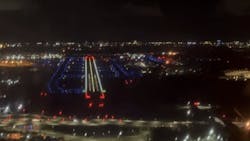Daytona Beach International Airport (DAB) recently completed a critical airfield infrastructure upgrade that underscores its commitment to operational excellence, energy efficiency, and long-term sustainability.
The Runway 7L-25R LED Lighting Improvements Project, finalized in just 21 days, replaced legacy incandescent lighting with a modern, high-efficiency LED system. As the primary air carrier runway at DAB, 7L-25R plays a pivotal role in supporting one of Florida's busiest airfields, serving both commercial carriers and an ever-growing population of flight school operations.
"Our goal was to modernize the lighting system to improve visibility, reliability and sustainability," said Eric Hakanen, Facilities Engineer at Daytona Beach International Airport. "The results speak for themselves—not only in terms of operational safety, but also with dramatic energy savings and reduced maintenance requirements."
The impetus for the upgrade stemmed from the need to match the intensity and efficiency of existing LED centerline lighting already in place at DAB. With the runway’s significant role in airfield operations, upgrading to LED edge and threshold lighting was a priority to align with DAB's strategic vision for long-term safety and reliability.
The project included the replacement of approximately 114 runway edge light fixtures and transformers, 24 threshold and displaced threshold lights, two constant current regulators, and roughly 72,000 feet of 5KV conductor. Additionally, the team installed 30 field lighting arrestors and made critical vault modifications to support the new system.
"Safety for commercial airlines and the growing number of student pilots was top of mind," Hakanen said. "Upgrading this lighting system strengthens our capacity to handle increasing air traffic, especially in nighttime and low-visibility conditions."
Design, Construction and Execution
Executing a full runway lighting upgrade in less than a month required precise coordination and extensive stakeholder engagement. The project team implemented a robust outreach program to align the construction window with flight schedules from airlines and multiple flight schools. May was selected as the optimal time, avoiding the disruptions of summer weather and aligning with periods of reduced operational demand.
Throughout the construction phase, the airport closed Runway 7L-25R but managed to maintain full operational capability. Aircraft were rerouted to secondary runway 16/34 with support from detailed NOTAMs and weekly progress updates to stakeholders.
"We communicated with stakeholders daily and provided updated taxi routes, barricade maps, and project phases to minimize confusion and disruption," said Mark Goodacre, A.C.E., Airfield Lighting Design Manager at AVCON, INC. "It was a comprehensive approach that involved our Airport Operations, Maintenance, and Projects teams working side-by-side with the contractor."
To reduce closure time, crews worked through the night, especially at taxiway crossings, which presented some of the most logistically complex segments of the project. Temporary rerouting of circuits ensured sections of the airfield remained illuminated for safe aircraft movement while construction progressed.
"The project was built on a detailed execution plan that benefited from constant collaboration and flexibility," added Robert Hambrecht, PE, Vice President at AVCON, INC. "Using overnight hours and maintaining close coordination with our contractor allowed us to finish on time and on budget."
Lessons Learned and Funding Overview
The 7L-25R LED Lighting Improvements Project not only delivered a safer and more efficient airfield but also provided valuable insights into project management under tight constraints. One of the most impactful lessons, according to Hambrecht, was the utility of segmented circuits and improved bonding practices to expedite diagnostics and minimize downtime in the future.
"We designed a circuiting method that reduces downtime significantly if a fault occurs," Hambrecht explained. "Combined with resilient connector kits and lightning damage mitigation features, this ensures high system reliability."
The LED system offers significant benefits: lower energy usage, reduced re-lamping, improved photometric performance, and better color consistency under various lighting conditions. These advantages reduce costs related to labor, electricity, and bulb disposal—an outcome that directly supports DAB’s sustainability goals.
While specific funding details were not publicly disclosed, the project aligns with ongoing federal and state efforts to modernize airport infrastructure, with many similar upgrades often leveraging Airport Improvement Program (AIP) grants and energy-focused funding mechanisms.
A Vision for the Future
With nearly 70% of its airfield lighting now converted to LED, DAB is committed to reaching 100% LED deployment within the next five years. The airport views this project as a critical milestone in achieving that vision.
"This initiative is about more than just lighting. It’s part of a broader effort to create a sustainable, safe, and efficient airport for all users—commercial carriers, flight schools, and the traveling public," Hakanen said.
The project has also sparked interest from other Florida airports, with peers in St. Augustine and Melbourne inquiring about DAB’s approach to maintenance and construction. By actively sharing its experiences through the Florida Airports Council Maintenance Committee, DAB is positioning itself as a resource for best practices in airfield modernization.
"We’re proud of what we accomplished here," Hambrecht said. "And we’re eager to continue sharing our lessons and supporting innovation in airport infrastructure across the state and beyond."




